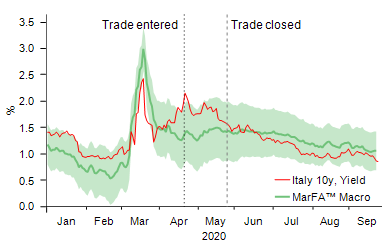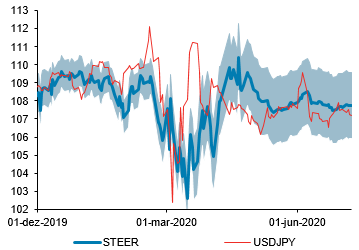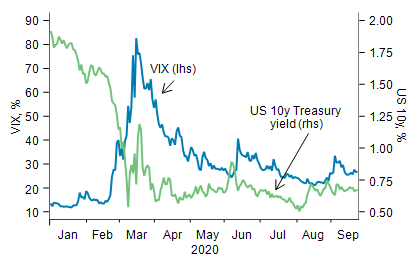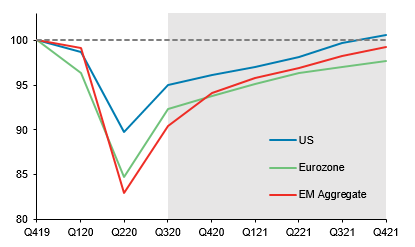In the calmest conditions, markets are awash with data, which
investors and banks harness to get ahead of trends, navigate volatility and
generate returns. In a crisis, this challenge rapidly escalates until the flow
of data becomes an overload.
In the face of this, experienced economists have an
ability to read market conditions that cannot be
replicated artificially, but can be greatly enhanced with sophisticated
quantitative analysis, argues Michael Sneyd, Head of Macro Quant &
Derivative Strategy, in BNP Paribas’ Markets 360 Economics and Strategy team. Quants,
economists and strategists working together, he believes, hold the key to helping
professional investors cut through the overload: it is a dream team that has
risen to the challenge of enabling clients to deal with one of the most
turbulent and volatile periods in the history of capital markets.
Quantitative models have now become more mainstream in the investment industry, as we’re seeing increased investment in tech and machine learning. In your view, why is quant so attractive both for clients and for banks?
One of the appeals of quant is its efficiency in bringing together high volumes of different sources of information and distilling those into investment ideas. The second factor for clients is that it can also help generate new ideas; by being able to bring in a broader set of information, quantitative analysis can help identify investment themes, and trade ideas, which otherwise might have been missed.We’re seeing an increased interest from investors in quant, and we’re actively fulfilling that demand by developing analytics which help bring information and market knowledge to the fingertips of our more senior analysts, helping them to make investment judgments quicker while giving them a broader set of information to work with.
It seems that AI and data science are now a big part of establishing investment strategies. Talk us through this idea of economists working with quants, as a “dream team”?
More and more investors want to understand not only what a systematic strategy recommends but also how it landed at its conclusion. Having quant analysis paired up with qualitative research and input from economists brings that extra dimension.The ability to generate unique trade ideas is another reason why we’re seeing a greater fusion between quant strategies and traditional economic analysis. The power of this collaboration is in combining the intuition, experience and knowledge of an economist as a starting point, then applying quant methodology to approach a problem systematically, harnessing the technology to arrive at a rounded, balanced solution.
Through the Coronavirus crisis, how are you providing relevant information to clients in rapidly moving markets?
The Covid-19 crisis has been challenging for some quant strategies, because of the extreme fluctuation in the markets. In this critical time, we have been leveraging heavily on combining quant processes with qualitative judgments. When receiving a trading signal, we would instantly assess it against our qualitative views to ensure its relevance.In parallel, we have been much more closely assessing the fundamentals of the models by checking whether or not the conditions that they usually work under are still in place and how they are adapting to the changes in the market. What we find in crises like this is that quant processes are still very useful, but the qualitative oversight is more important than ever.
For example, In February our MarFA™ Macro model indicated that Italian 10-year yields appeared too elevated, but the statistical confidence in the signal was low. This helped us to avoid being caught positioned the wrong way when yields later spiked to 2.4%. Later in April when yields were around 2.0% the model indicated that yields were again too high by around 65b compared to their fair value of 1.4%. This time, however, conditions were in place for a strong signal from the model. This triggered us to enter a long Italian 10y BTP trade idea which benefited from the decline of yield in May of this year.

| Example of a successful quant case study at BNP Paribas The STEER™ model (Short Term Equilibrium Exchange Rate) is in effect a short-term model for predicting exchange rates, developed in 2012 by BNP Paribas. Quant models like these were built for qualitative strategists to help generate trade ideas, understand what’s driving the currencies, and so on. STEER™ was a proof of concept, developed for one asset class at the time, but once the macro quant team was set up in October 2018, it was time to expand that concept across all asset classes. STEER™ was initially designed to provide a quantitative input for discretionary investors. Soon after its release it was developed in coordination with BNP Paribas’ QIS team into a tradable index, allowing clients to invest directly into the STEER™ trading strategy. The model has seen success since its launch: early on during the Coronavirus crisis, the STEER™ model gained about 10%, showing just how useful it was to investors navigating an unprecedented market environment. The strategy benefits from the overshooting of exchange rates vis-à-vis other assets, which typically occurs during periods of increased volatility such as this. One of the appeals of the strategy is that it has quite diversified exposure; the model gives clients a defensive exposure meaning the strategy tends to do well when a lot of other more market-sensitive strategies do poorly. Additionally, for systematic investors, the STEER™ model is a useful tool to bring a new estimation approach. The index uses what’s called a ‘co-integration theory’ which assumes that asset prices tend to move together over time. This was typically used in economic-based models and had not previously been used in asset-pricing models, particularly over short time horizons. When BNP Paribas launched the model it presented a new approach for assessing exchange rates over a one-to-two week time horizon. |

Public behaviour is an important consideration for the economic impact of Covid-19. How do quant approaches help?
Even before Covid-19, behaviour and sentiment were becoming much more important to markets. With Covid-19, we’ve been putting even more effort into interpreting this information, in particular trying to use sentiment analysis to try and get an indication of how the public feels about the situation.Firstly, we used web scraping of news outlets in order to see how much focus on Covid-19 there was in the media. This was particularly useful at the start of the crisis because it gave us a real indication of how much people were being exposed to Covid-19-related news. We called it ‘news trend analytics’.
Secondly, we used what we call the ‘indicator of public concerns’ (IPC). We built this indicator to try assess how the general public is feeling about the Covid-19 crisis by looking at what search terms people are using in Google. From those analytics, we can see how concerned people are about different topics. For example, we’ve been comparing the number of searches related to the economy versus the number of phrases related to Covid-19 and particularly health concerns around it. The idea was to understand how much is public concern more focused on jobs, the economy, or unemployment versus how much they focused on health and the spread of the virus.
The results are quite interesting: the US saw twice as many search terms about unemployment as there were on health and the virus. In the UK, by comparison, search volumes related to health topics were 30 times greater than those related to unemployment during the lockdown period. I think this reflects how greater state support for the economy leads to fewer worries about unemployment. This information was useful to investors when adjusting investments as it provided a timely indicator of the concerns of the public and insight into future spending patterns.
The third approach was to look at the geolocation data, seeing how people are moving around, how busy different locations are based on mobile phones. Analysing how busy transport, retail stores, airports and railway stations are has provided us with a sense of the extent and the speed that economies across the globe are returning to normal.
How does your approach adapt to different types of investors?
While we have our core product range, different types of clients consume our products in slightly different ways, so our service is adaptable.Macro and discretionary investors don’t necessarily have the expertise in-house to build out quantitative models, so we develop those for them. We share the outputs and make them digestible, while taking them through how they can incorporate those models into an investment process. That way, clients can start implementing a quant approach without having to invest the time and money into developing these models internally.
Systematic investors build their own quant models and have a lot of in-house expertise. We offer them an advisory service to help them with their own model development process by sharing our own findings.
Investors who invest in systematic risk premia strategies typically use our BNP Paribas QIS (Quantitative Investment Strategies) offer. The QIS team runs the strategy, the modelling and the trade execution without any input from the client. We then analyse the performance of the strategy compared to what is happening in the economy and in markets.
In other words, developing quantitative models to support our economists and qualitative strategists delivers more accurate, efficient and innovative investment strategies for our clients. The collaboration between the two has been more relevant than ever during the crisis, and we expect client demand to continue to increase.
To learn more about Markets 360 Strategy and Economics from BNP Paribas, click here.
BNP Paribas does not consider this content to be “Research” as defined under the MiFID II unbundling rules. If you are subject to inducement and unbundling rules, you should consider making your own assessment as to the characterisation of this content.
Legal notice for marketing documents, referencing to whom this communication is directed.

